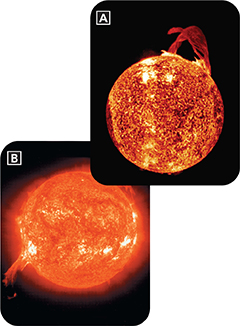Sunspots provide astronomers with insights into the motions of the sun. The Italian scientist Galileo Galilei discovered that the sun rotates by observing the motion of sunspots. Later observations showed that the sun doesn't spin as a solid body the way Earth does. Instead, sunspots near the sun's equator move faster than sunspots near the sun's poles. This means that the sun rotates faster at its equator than near its poles.
Prominences
Prominences are spectacular features of the sun's atmosphere that occur near sunspots. As shown in Figure 7A, prominences are huge loops of gas that erupt from sunspot regions. They extend upward from the photosphere into the chromosphere and sometimes into the corona. Prominences travel along the magnetic field lines that connect sunspots. Some prominences reach heights of more than 100,000 kilometers above the sun's surface.
Figure 7 The sun's magnetic field produces prominences and flares visible with special red filters. A This prominence forms a huge twirling loop connecting sunspot regions. B A solar flare erupts on the edge of the sun.
 d
dSolar Flares
The sun's surface sometimes erupts dramatically, producing X-rays and hurling charged particles into space at speeds of 1000 km/s or more. Such a sudden release of energy from the sun is called a solar flare. Like prominences, solar flares usually occur near sunspots. Solar flares heat the corona to a temperature near 20 million K and greatly increase the solar wind. When the additional high-energy particles and radiation from a solar flare reach Earth, they can cause magnetic storms in Earth's upper atmosphere. These storms disrupt electric power transmission as well as radio, television, and telephone signals.
Section 26.1 Assessment
Reviewing Concepts
 What is the source of the sun's energy?
What is the source of the sun's energy? What two forces in the sun interact to produce a stable structure?
What two forces in the sun interact to produce a stable structure? List the layers of the sun's interior from the center outward and briefly describe each one.
List the layers of the sun's interior from the center outward and briefly describe each one. Describe each of the layers of the sun's atmosphere from the surface outward.
Describe each of the layers of the sun's atmosphere from the surface outward. Describe three features that exist on or above the sun's surface.
Describe three features that exist on or above the sun's surface.
Critical Thinking
Applying Concepts How have scientists learned about the sun's interior?
Calculating The sun's mass is more than 300,000 times the mass of Earth. The sun's volume is about 1,000,000 times that of Earth. How much denser is Earth than the sun?
Writing in Science
Describing the Sun Describe in a few paragraphs an imaginary journey to the center of the sun, beginning from its outermost layer. Include a description of each layer and at least two prominent features.




